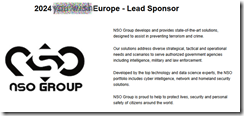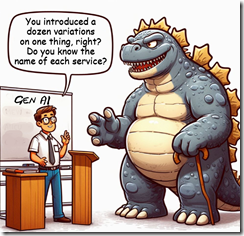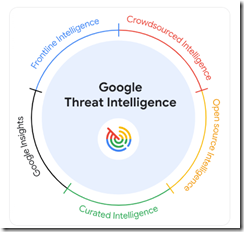Publication Founded by a Googler Cheers for Google AI Search
June 5, 2024
 This essay is the work of a dinobaby. Unlike some folks, no smart software improved my native ineptness.
This essay is the work of a dinobaby. Unlike some folks, no smart software improved my native ineptness.
To understand the “rah rah” portion of this article, you need to know the backstory behind Search Engine Land, a news site about search and other technology. It was founded by Danny Sullivan, who pushed the SEO bandwagon. He did this because he was angling for a job at Google, he succeeded, and now he’s the point person for SEO.
Another press release touting the popularity of Google search dropped: “Google SEO Says AI Overviews Are Increasing Search Usage.” The author Danny Goodwin remains skeptical about Google’s spiked popularity due to AI and despite the bias of Search Engine Land’s founder.
During the QI 2024 Alphabet earnings call, Google/Alphabet CEO Sundar Pichai said that the search engine’s generative AI has been used for billions of queries and there are plans to develop the feature further. Pichai said positive things about AI, including that it increased user engagement, could answer more complex questions, and how there will be opportunities for monetization.
Goodwin wrote:
“All signs continue to indicate that Google is continuing its slow evolution toward a Search Generative Experience. I’m skeptical about user satisfaction increasing, considering what an unimpressive product AI overviews and SGE continues to be. But I’m not the average Google user – and this was an earnings call, where Pichai has mastered the art of using a lot of words to say a whole lot of nothing.”
AI is the next evolution of search and Google is heading the parade, but the technology still has tons of bugs. Who founded the publication? A Googler. Of course there is no interaction between the online ad outfit and an SEO mouthpiece. Un-uh. No way.
Whitney Grace, June 5, 2024
So AI Is — Maybe, Just Maybe — Not the Economic Big Kahuna?
June 3, 2024
 This essay is the work of a dinobaby. Unlike some folks, no smart software improved my native ineptness.
This essay is the work of a dinobaby. Unlike some folks, no smart software improved my native ineptness.
I find it amusing how AI has become the go-to marketing word. I suppose if I were desperate, lacking an income, unsure about what will sell, and a follow-the-hyperbole-type person I would shout, “AI.” Instead I vocalize, “Ai-Yai-Ai” emulating the tones of a Central American death whistle. Yep, “Ai-Yai-AI.”
Thanks, MSFT Copilot. A harbinger? Good enough.
I read “MIT Professor Hoses Down Predictions AI Will Put a Rocket under the Economy.” I won’t comment upon the fog of distrust which I discern around Big Name Universities, nor will I focus my adjustable Walgreen’s spectacles on MIT’s fancy dancing with the quite interesting and decidedly non-academic Jeffrey Epstein. Nope. Forget those two factoids.
The write up reports:
…Daron Acemoglu, professor of economics at Massachusetts Institute of Technology, argues that predictions AI will improve productivity and boost wages in a “blue-collar bonanza” are overly optimistic.
The good professor is rowing against the marketing current. According to the article, the good professor identifies some wild and crazy forecasts. One of these is from an investment bank whose clients are unlikely to be what some one percenters perceive as non-masters of the universe.
That’s interesting. But it pales in comparison to the information in “Few People Are Using ChatGPT and Other AI Tools Regularly, Study Suggests.” (I love suggestive studies!) That write up reports about a study involving Thomson Reuters, the “trust” outfit:
Carried out by the Reuters Institute and Oxford University and involving 6,000 respondents from the U.S., U.K., France, Denmark, Japan, and Argentina, the researchers found that OpenAI’s ChatGPT is by far the most widely used generative-AI tool and is two or three times more widespread than the next most widely used products — Google Gemini and Microsoft Copilot. But despite all the hype surrounding generative AI over the last 18 months, only 1% of those surveyed are using ChatGPT on a daily basis in Japan, 2% in France and the UK, and 7% in the U.S. The study also found that between 19% and 30% of the respondents haven’t even heard of any of the most popular generative AI tools, and while many of those surveyed have tried using at least one generative-AI product, only a very small minority are, at the current time, regular users deploying them for a variety of tasks.
My hunch is that these contrarians want clicks. Well, the tactic worked for me. However, how many of those in AI-Land will take note? My thought is that these anti-AI findings are likely to be ignored until some of the Big Money folks lose their cash. Then the voices of negativity will be heard.
Several observations:
- The economics of AI seem similar to some early online ventures like Pets.com, not “all” mind you, just some
- Expertise in AI may not guarantee a job at a high-flying techno-feudalist outfit
- The difficulties Google appears to be having suggest that the road to AI-Land on the information superhighway may have some potholes. (If Google cannot pull AI off, how can Bob’s Trucking Company armed with Microsoft Word with Copilot?)
Net net: It will be interesting to monitor the frequency of “AI balloon deflating” analyses.
Stephen E Arnold, June 3, 2024
x
NSO Group: Making Headlines Again and Again and Again
May 31, 2024
 This essay is the work of a dinobaby. Unlike some folks, no smart software improved my native ineptness.
This essay is the work of a dinobaby. Unlike some folks, no smart software improved my native ineptness.
NSO Group continues to generate news. One example is the company’s flagship sponsorship of an interesting conference going on in Prague from June 4th to the 6th. What’s interesting mean? I think those who attend the conference are engaged in information-related activities connected in some way to law enforcement and intelligence. How do I know NSO Group ponied up big bucks to be the “lead sponsor”? Easy. I saw this advertisement on the conference organizer’s Web site. I know you want me to reveal the url, but I will treat the organizer in a professional manner. Just use those Google Dorks, and you will locate the event. The ad:
What’s the ad from the “lead sponsor” say? Here are a few snippets from the marketing arm of NSO Group:
NSO Group develops and provides state-of-the-art solutions, designed to assist in preventing terrorism and crime. Our solutions address diverse strategical, tactical and operational needs and scenarios to serve authorized government agencies including intelligence, military and law enforcement. Developed by the top technology and data science experts, the NSO portfolio includes cyber intelligence, network and homeland security solutions. NSO Group is proud to help to protect lives, security and personal safety of citizens around the world.
Innocent stuff with a flavor jargon-loving Madison Avenue types prefer.
Citizen’s Lab is a bit like mules in an old-fashioned grist mill. The researchers do not change what they think about. Source: Royal Mint Museum in the UK.
Just for some fun, let’s look at the NSO Group through a different lens. The UK newspaper The Guardian, which counts how many stories I look at a year, published “Critics of Putin and His Allies Targeted with Spyware Inside the EU.” Here’s a sample of the story’s view of NSO Group:
At least seven journalists and activists who have been vocal critics of the Kremlin and its allies have been targeted inside the EU by a state using Pegasus, the hacking spyware made by Israel’s NSO Group, according to a new report by security researchers. The targets of the hacking attempts – who were first alerted to the attempted cyber-intrusions after receiving threat notifications from Apple on their iPhones – include Russian, Belarusian, Latvian and Israeli journalists and activists inside the EU.
And who wrote the report?
Access Now, the Citizen Lab at the Munk School of Global Affairs & Public Policy at the University of Toronto (“the Citizen Lab”), and independent digital security expert Nikolai Kvantiliani
The Citizen Lab has been paying attention to NSO Group for years. The people surveilled or spied upon via the NSO Group’s Pegasus technology are anti-Russia; that is, none of the entities will be invited to a picnic at Mr. Putin’s estate near Sochi.
Obviously some outfit has access to the Pegasus software and its command-and-control system. It is unlikely that NSO Group provided the software free of charge. Therefore, one can conclude that NSO Group could reveal what country was using its software for purposes one might consider outside the bounds of the write up’s words cited above.
NSO Group remains one of the — if not the main — poster children for specialized software. The company continues to make headlines. Its technology remains one of the leaders in the type of software which can be used to obtain information for a mobile device. There are some alternatives, but NSO Group remains the Big Dog.
One wonders why Israel, presumably with the Pegasus tool, could not have obtained information relevant to the attack in October 2023. My personal view is that having Fancy Dan ways to get data from a mobile phone, human analysts have to figure out what’s important and what to identify as significant.
My point is that the hoo-hah about NSO Group and Pegasus may not be warranted. Information without the trained analysts and downstream software may have difficulty getting the information required to take a specific action. Israel’s lack of intelligence means that software alone can’t do the job. No matter what the marketing material says or how slick the slide deck used to brief those with a “need to know” appears — software is not intelligence.
Will NSO Group continue to make headlines? Probably. Those with access to Pegasus will make errors and disclose their ineptness. Citizen’s Lab will be at the ready. New reports will be forthcoming.
Net net: Is anyone surprised Mr. Putin is trying to monitor anti-Russia voices? Is Pegasus the only software pressed into service? My answer to this question is: “Mr. Putin will use whatever tool he can to achieve his objectives.” Perhaps Citizen’s Lab should look for other specialized software and expand its opportunities to write reports? When will Apple address the vulnerability which NSO Group continues to exploit?
Stephen E Arnold, May 31, 2024
Apple Fan Misses the Obvious: MSFT Marketing Is Tasty
May 28, 2024
 This essay is the work of a dinobaby. Unlike some folks, no smart software improved my native ineptness.
This essay is the work of a dinobaby. Unlike some folks, no smart software improved my native ineptness.
I love anecdotes seasoned investigators offer at law enforcement and intelligence conferences. Statements like “I did nothing wrong” are accompanied by a weapon in a waistband. Or, “You can take my drugs.” Yep, those are not informed remarks in some situations. But what happens when poohbahs and would-be experts explain in 2,600 words how addled Microsoft’s announcements were at its Build conference. “Microsoft’s Copilot PC and the M3 Mac Killer Myth” is an interesting argumentative essay making absolutely clear as fresh, just pressed apple cider in New Hampshire. (Have you ever seen the stuff?)
The Apple Cider judge does not look happy. Has the innovation factory failed with filtration? Thanks, MSFT Copilot. How is that security initiative today?
The write up provides a version of “tortured poet” writing infused with techno-talk. The object of the write up is to make as clear as the aforementioned apple cider several points to which people are not directing attention; to wit:
- Microsoft has many failures; for example, the Windows Phone, Web search, and, of course, crappy Windows in many versions
- Microsoft follows what Apple does; for example, smart software like facial recognition on a user’s device
- Microsoft fouled up with its Slate PC and assorted Windows on Arm efforts.
So there.
Now Microsoft is, according to the write up:
Today, Microsoft is doing the exact same lazy thing to again try to garner some excitement about legacy Windows PCs, this time by tacking an AI chat bot. And specifically, the Bing Chat bot nobody cared about before Microsoft rebranded it as Copilot. Counting the Surface tablet and Windows RT, and the time Microsoft pretended to "design" its own advanced SoC just like Apple by putting RAM on a Snapdragon, this must be Microsoft’s third major attempt to ditch Intel and deliver something that could compete with Apple’s iPad, or M-powered Macs, or even both.
The article provides a quick review of the technical innovations in Apple’s proprietary silicon. The purpose of the technology information is to make as clear as that New Hampshire, just-pressed juice that Microsoft will continue its track record of fouling up. The essay concludes with this “core” statement flavored with the pungency of hard cider:
Things incrementally change rapidly in the tech industry, except for Microsoft and its photocopy culture.
Interesting. However, I want to point out that Microsoft created a bit of a problem for Google in January 2023. Microsoft’s president announced its push into AI. Google, an ageing beastie, was caught with its claws retracted. The online advertising giant’s response was the Sundar & Prabhakar Comedy Show. It featured smart software which made factual errors, launched the Code Red or whatever odd ball name Googlers assigned to the problem Microsoft created.
Remember. The problem was not AI. Google “invented” some of the intestines of OpenAI’s and Microsoft’s services. The kick in the stomach was marketing. Microsoft’s announcement captured attention and made — much to the chagrin of the online advertising service — look old and slow, not smooth and fast like those mythical US Navy Seals of technology. Google dropped the inflatable raft and appears to be struggling against a rather weak rip tide.
What Microsoft did at Build with its semi-wonky and largely unsupported AI PC announcement was marketing. The Apple essay ignores the interest in a new type of PC form factor that includes the allegedly magical smart software. Mastery of smart software means work, better grades, efficiency, and a Cybertruck filled with buckets of hog wash.
But that may not matter.
Apple, like Google, finds itself struggling to get its cider press hooked up and producing product. One can criticize the Softies for technology. But I have to admit that Microsoft is reasonably adept at marketing its AI efforts. The angst in the cited article is misdirected. Apple insiders should focus on the Microsoft marketing approach. With its AI messaging, Microsoft has avoided the craziness of the iPad’s squashing creativity.
Will the AI PC work? Probably in an okay way. Has Microsoft’s AI marketing worked? It sure looks like it.
Stephen E Arnold, May 28, 2024
Googzilla Versus OpenAI: Moving Up to Pillow Fighting
May 17, 2024
 This essay is the work of a dinobaby. Unlike some folks, no smart software improved my native ineptness.
This essay is the work of a dinobaby. Unlike some folks, no smart software improved my native ineptness.
Mike Tyson is dressed in a Godzilla outfit. He looks like a short but quite capable Googzilla. He is wearing a Google hat. (I have one, but it is soiled. Bummer.) Googzilla is giving the stink eye to Sam AI-Man, who has followed health routines recommended by Huberman Lab and Anatoly, the fellow who hawks supplements after shaming gym brutes dressed as a norm core hero.
Sam AI-Man asks an important question. Googzilla seems to be baffled. But the cane underscores that he is getting old for a thunder lizard selling online advertising. Thanks, MSFT Copilot. How are the security initiatives coming along? Oh, too bad.
Now we have the first exhibition: Googzilla is taking on Sam AI-Man.
I read an analysis of this high-stakes battle in “ChatGPT 4o vs Gemini 1.5 Pro: It’s Not Even Close.” The article appeared in the delightfully named online publication “Beebom.” I am writing in Beyond Search, which is — quite frankly — a really boring name. But I am a dinobaby, and I am going to assume that Beebom has a much more tuned in owner operator.
The article illustrates a best practice in database comparison, just tweaked to provide some insights into how alike or different the Googzilla is from the AI-Man. There’s a math test. There is a follow the instructions query. There is an image test. A programming challenge. You get the idea. The article includes what a reader will need to run similar brain teasers to Googzilla and Sam AI-Man.
Who cares? Let’s get to the results.
The write up says:
It’s evidently clear that Gemini 1.5 Pro is far behind ChatGPT 4o. Even after improving the 1.5 Pro model for months while in preview, it can’t compete with the latest GPT-4o model by OpenAI. From commonsense reasoning to multimodal and coding tests, ChatGPT 4o performs intelligently and follows instructions attentively. Not to miss, OpenAI has made ChatGPT 4o free for everyone.
Welp. This statement is not going to make Googzilla happy. Anyone who plays Foosball with the beastie today will want to be alert that re-Fooses are not allowed. You lose when you what the ball out of the game.
But the sun has not set over the Googzilla computer lab. The write up opines:
The only thing going for Gemini 1.5 Pro is the massive context window with support for up to 1 million tokens. In addition, you can upload videos too which is an advantage. However, since the model is not very smart, I am not sure many would like to use it just for the larger context window.
I chuckled at the last line of the write up:
If Google has to compete with OpenAI, a substantial leap is required.
Several observations:
- Who knows the names of the “new” products Google rolled out?
- With numerous “new” products, has Google a grand vision or is it one of those high school stunts in which passengers in a luxury car jump out and run around the car shouting. Then the car drives off?
- Will Google’s management align its AI with its staff management methods in the context of the regulatory scrutiny?
- Where’s DeepMind in this somewhat confusing flood of “new” smart products?
Net net: Google is definitely showing the results of having its wizards work under Code Red’s flashing lights. More pillow fights ahead. (Can you list the “new” products announced at Google I/O? Don’t worry. Neither can I.)
Stephen E Arnold, May 17, 2024
Apple and a Recycled Carnival Act: Woo Woo New New!
May 13, 2024
 This essay is the work of a dinobaby. Unlike some folks, no smart software improved my native ineptness.
This essay is the work of a dinobaby. Unlike some folks, no smart software improved my native ineptness.
A long time ago, for a project related to a new product which was cratering, one person on my team suggested I read a book by James B. Twitchell. Carnival Culture: The Trashing of Taste in America provided a broad context, but the information in the analysis of taste was not going to save the enterprise software I was supposed to analyze. In general, I suggest that investment outfits with an interest in online information give me a call before writing checks to the tale-spinning entrepreneurs.
A small creative spark getting smashed in an industrial press. I like the eyes. The future of humans in Apple’s understanding of the American datasphere. Wow, look at those eyes. I can hear the squeals of pain, can’t you?
Dr. Twitchell did a good job, in my opinion, of making clear that some cultural actions are larger than a single promotion. Popular movies and people like P.T. Barnum (the circus guy) explain facets of America. These two examples are not just entertaining; they are making clear what revs the engines of the US of A.
I read “Hating Apple Goes Mainstream” and realized that Apple is doing the marketing for which it is famous. The roll out of the iPad had a high resolution, big money advertisement. If you are around young children, squishy plastic toys are often in small fingers. Squeeze the toy and the eyes bulge. In the image above, a child’s toy is smashed in what seems to me be the business end of a industrial press manufactured by MSE Technology Ltd in Turkey.
Thanks, MSFT Copilot. Glad you had time to do this art. I know you are busy on security or is it AI or is AI security or security AI? I get so confused.
The Apple iPad has been a bit of an odd duck. It is a good substitute for crappy Kindle-type readers. We have a couple, but they don’t get much use. Everything is a pain for me because the super duper Apple technology does not detect my fingers. I bought the gizmos so people could review the PowerPoint slides for one of my lectures at a conference. I also experimented with the iPad as a teleprompter. After a couple of tests, getting content on the device, controlling it, and fiddling so the darned thing knew I was poking the screen to cause an action — I put the devices on the shelf.
Forget the specific product, let’s look at the cited write ups comments about the Apple “carnival culture” advertisement. The write up states:
Apple has lost its presumption of good faith over the last five years with an ever-larger group of people, and now we’ve reached a tipping point. A year ago, I’m sure this awful ad would have gotten push back, but I’m also sure we’d heard more “it’s not that big of a deal” and “what Apple really meant to say was…” from the stalwart Apple apologists the company has been able to count on for decades. But it’s awfully quiet on the fan-boy front.
I think this means the attempt to sell sent weird messages about a company people once loved. What’s going on, in my opinion, is that Apple is explaining what technology is going to do to people who once used software to create words, images, and data exhaust will be secondary to cosmetics of technology.
In short, people and their tools will be replaced by a gizmo or gizmos that are similar to bright lights and circus posters. What do these artifacts tell us. My take on the Apple iPad M4 super duper creative juicer is, at this time:
- So what? I have an M2 Air, and it does what I hoped the two touch insensitive iPads would do.
- Why create a form factor that is likely to get crushed when I toss my laptop bad on a security screening belt? Apple’s products are, in my view, designed to be landfill residents.
- Apple knows in its subconscious corporate culture heat sink that smart software, smart services, and dumb users are the future. The wonky expensive high-resolution shouts, “We know you are going to be out of job. You will be like the yellow squishy toy.”
The message Apple is sending is that innovation has moved from utility to entertainment to the carnival sideshow. Put on your clown noses, people. Buy Apple.
Stephen E Arnold, May 13, 2024
Google Stomps into the Threat Intelligence Sector: AI and More
May 7, 2024
 This essay is the work of a dinobaby. Unlike some folks, no smart software improved my native ineptness.
This essay is the work of a dinobaby. Unlike some folks, no smart software improved my native ineptness.
Before commenting on Google’s threat services news. I want to remind you of the link to the list of Google initiatives which did not survive. You can find the list at Killed by Google. I want to mention this resource because Google’s product innovation and management methods are interesting to say the least. Operating in Code Red or Yellow Alert or whatever the Google crisis buzzword is, generating sustainable revenue beyond online advertising has proven to be a bit of a challenge. Google is more comfortable using such methods as [a] buying and trying to scale it, [b] imitating another firm’s innovation, and [c] dumping big money into secret projects in the hopes that what comes out will not result in the firm’s getting its “glass” kicked to the curb.
Google makes a big entrance at the RSA Conference. Thanks, MSFT Copilot. Have you considerate purchasing Google’s threat intelligence service?
With that as background, Google has introduced an “unmatched” cyber security service. The information was described at the RSA security conference and in a quite Googley blog post “Introducing Google Threat Intelligence: Actionable threat intelligence at Google Scale.” Please, note the operative word “scale.” If the service does not make money, Google will “not put wood behind” the effort. People won’t work on the project, and it will be left to dangle in the wind or just shot like Cricket, a now famous example of animal husbandry. (Google’s Cricket was the Google Appliance. Remember that? Take over the enterprise search market. Nope. Bang, hasta la vista.)
Google’s new service aims squarely at the comparatively well-established and now maturing cyber security market. I have to check to see who owns what. Venture firms and others with money have been buying promising cyber security firms. Google owned a piece of Recorded Future. Now Recorded Future is owned by a third party outfit called Insight. Darktrace has been or will be purchased by Thoma Bravo. Consolidation is underway. Thus, it makes sense to Google to enter the threat intelligence market, using its Mandiant unit as a springboard, one of those home diving boards, not the cliff in Acapulco diving platform.
The write up says:
we are announcing Google Threat Intelligence, a new offering that combines the unmatched depth of our Mandiant frontline expertise, the global reach of the VirusTotal community, and the breadth of visibility only Google can deliver, based on billions of signals across devices and emails. Google Threat Intelligence includes Gemini in Threat Intelligence, our AI-powered agent that provides conversational search across our vast repository of threat intelligence, enabling customers to gain insights and protect themselves from threats faster than ever before.
Google to its credit did not trot out the “quantum supremacy” lingo, but the marketers did assert that the service offers “unmatched visibility in threats.” I like the “unmatched.” Not supreme, just unmatched. The graphic below illustrates the elements of the unmatchedness:
Credit to the Google 2024
But where is artificial intelligence in the diagram? Don’t worry. The blog explains that Gemini (Google’s AI “system”) delivers
AI-driven operationalization
But the foundation of the new service is Gemini, which does not appear in the diagram. That does not matter, the Code Red crowd explains:
Gemini 1.5 Pro offers the world’s longest context window, with support for up to 1 million tokens. It can dramatically simplify the technical and labor-intensive process of reverse engineering malware — one of the most advanced malware-analysis techniques available to cybersecurity professionals. In fact, it was able to process the entire decompiled code of the malware file for WannaCry in a single pass, taking 34 seconds to deliver its analysis and identify the kill switch. We also offer a Gemini-driven entity extraction tool to automate data fusion and enrichment. It can automatically crawl the web for relevant open source intelligence (OSINT), and classify online industry threat reporting. It then converts this information to knowledge collections, with corresponding hunting and response packs pulled from motivations, targets, tactics, techniques, and procedures (TTPs), actors, toolkits, and Indicators of Compromise (IoCs). Google Threat Intelligence can distill more than a decade of threat reports to produce comprehensive, custom summaries in seconds.
I like the “indicators of compromise.”
Several observations:
- Will this service be another Google Appliance-type play for the enterprise market? It is too soon to tell, but with the pressure mounting from regulators, staff management issues, competitors, and savvy marketers in Redmond “indicators” of success will be known in the next six to 12 months
- Is this a business or just another item on a punch list? The answer to the question may be provided by what the established players in the threat intelligence market do and what actions Amazon and Microsoft take. Is a new round of big money acquisitions going to begin?
- Will enterprise customers “just buy Google”? Chief security officers have demonstrated that buying multiple security systems is a “safe” approach to a job which is difficult: Protecting their employers from deeply flawed software and years of ignoring online security.
Net net: In a maturing market, three factors may signal how the big, new Google service will develop. These are [a] price, [b] perceived efficacy, and [c] avoidance of a major issue like the SolarWinds’ matter. I am rooting for Googzilla, but I still wonder why Google shifted from Recorded Future to acquisitions and me-too methods. Oh, well. I am a dinobaby and cannot be expected to understand.
Stephen E Arnold, May 7, 2024
The Everything About AI Report
May 7, 2024
 This essay is the work of a dinobaby. Unlike some folks, no smart software improved my native ineptness.
This essay is the work of a dinobaby. Unlike some folks, no smart software improved my native ineptness.
I read the Stanford Artificial Intelligence Report. If you have have not seen the 500 page document, click here. I spotted an interesting summary of the document. “Things Everyone Should Understand About the Stanford AI Index Report” is the work of Logan Thorneloe, an author previously unknown to me. I want to highlight three points I carried away from Mr. Thorneloe’s essay. These may make more sense after you have worked through the beefy Stanford document, which, due to its size, makes clear that Stanford wants to be linked to the the AI spaceship. (Does Stanford’s AI effort look like Mr. Musk’s or Mr. Bezos’ rocket? I am leaning toward the Bezos design.)
An amazed student absorbs information about the Stanford AI Index Report. Thanks, MSFT. Good enough.
The summary of the 500 page document makes clear that Stanford wants to track the progress of smart software, provide a policy document so that Stanford can obviously influence policy decisions made by people who are not AI experts, and then “highlight ethical considerations.” The assumption by Mr. Thorneloe and by the AI report itself is that Stanford is equipped to make ethical anything. The president of Stanford departed under a cloud for acting in an unethical manner. Plus some of the AI firms have a number of Stanford graduates on their AI teams. Are those teams responsible for depictions of inaccurate historical personages? Okay, that’s enough about ethics. My hunch is that Stanford wants to be perceived as a leader. Mr. Thorneloe seems to accept this idea as a-okay.
The second point for me in the summary is that Mr. Thorneloe goes along with the idea that the Stanford report is unbiased. Writing about AI is, in my opinion of course, inherently biased. That’s’ the reason there are AI cheerleaders and AI doomsayers. AI is probability. How the software gets smart is biased by [a] how the thresholds are rigged up when a smart system is built, [b] the humans who do the training of the system and then “fine tune” or “calibrate” the smart software to produce acceptable results, and [b] the information used to train the system. More recently, human developers have been creating wrappers which effectively prevent the smart software from generating pornography or other “improper” or “unacceptable” outputs. I think the “bias” angle needs some critical thinking. Stanford’s report wants to cover the AI waterfront as Stanford maps and presents the geography of AI.
The final point is the rundown of Mr. Thorneloe’s take-aways from the report. He presents ten. I think there may just be three. First, the AI work is very expensive. That leads to the conclusion that only certain firms can be in the AI game and expect to win and win big. To me, this means that Stanford wants the good old days of Silicon Valley to come back again. I am not sure that this approach to an important, yet immature technology, is a particularly good idea. One does not fix up problems with technology. Technology creates some problems, and like social media, what AI generates may have a dark side. With big money controlling the game, what’s that mean? That’s a tough question to answer. The US wants China and Russia to promise not to use AI in their nuclear weapons system. Yeah, that will work.
Another take-away which seems important is the assumption that workers will be more productive. This is an interesting assertion. I understand that one can use AI to eliminate call centers. However, has Stanford made a case that the benefits outweigh the drawbacks of AI? Mr. Thorneloe seems to be okay with the assumption underlying the good old consultant-type of magic.
The general take-away from the list of ten take-aways is that AI is fueled by “industry.” What happened the Stanford Artificial Intelligence Lab, synthetic data, and the high-confidence outputs? Nothing has happened. AI hallucinates. AI gets facts wrong. AI is a collection of technologies looking for problems to solve.
Net net: Mr. Thorneloe’s summary is useful. The Stanford report is useful. Some AI is useful. Writing 500 pages about a fast moving collection of technologies is interesting. I cannot wait for the 2024 edition. I assume “everyone” will understand AI PR.
Stephen E Arnold, May 7, 2024
Microsoft Security Messaging: Which Is What?
May 6, 2024
 This essay is the work of a dinobaby. Unlike some folks, no smart software improved my native ineptness.
This essay is the work of a dinobaby. Unlike some folks, no smart software improved my native ineptness.
I am a dinobaby. I am easily confused. I read two “real” news items and came away confused. The first story is “Microsoft Overhaul Treats Security As Top Priority after a Series of Failures.” The subtitle is interesting too because it links “security” to monetary compensation. That’s an incentive, but why isn’t security just part of work at an alleged monopoly’s products and services? I surmise the answer is, “Because security costs money, a lot of money.” That article asserts:
After a scathing report from the US Cyber Safety Review Board recently concluded that “Microsoft’s security culture was inadequate and requires an overhaul,” it’s doing just that by outlining a set of security principles and goals that are tied to compensation packages for Microsoft’s senior leadership team.
Okay. But security emerges from basic engineering decisions; for instance, does a developer spend time figuring out and resolving security when dependencies are unknown or documented only by a grousing user in a comment posted on a technical forum? Or, does the developer include a new feature and moves on to the next task, assuming that someone else or an automated process will make sure everything works without opening the door to the curious bad actor? I think that Microsoft assumes it deploys secure systems and that its customers have the responsibility to ensure their systems’ security.
The cyber racoons found the secure picnic basket was easily opened. The well-fed, previously content humans seem dismayed that their goodies were stolen. Thanks, MSFT Copilot. Definitely good enough.
The write up adds that Microsoft has three security principles and six security pillars. I won’t list these because the words chosen strike me like those produced by a lawyer, an MBA, and a large language model. Remember. I am a dinobaby. Six plus three is nine things. Some car executive said a long time ago, “Two objectives is no objective.” I would add nine generalizations are not a culture of security. Nine is like Microsoft Word features. No one can keep track of them because most users use Word to produce Words. The other stuff is usually confusing, in the way, or presented in a way that finding a specific feature is an exercise in frustration. Is Word secure? Sure, just download some nifty documents from a frisky Telegram group or the Dark Web.
The write up concludes with a weird statement. Let me quote it:
I reported last month that inside Microsoft there is concern that the recent security attacks could seriously undermine trust in the company. “Ultimately, Microsoft runs on trust and this trust must be earned and maintained,” says Bell. “As a global provider of software, infrastructure and cloud services, we feel a deep responsibility to do our part to keep the world safe and secure. Our promise is to continually improve and adapt to the evolving needs of cybersecurity. This is job #1 for us.”
First, there is the notion of trust. Perhaps Edge’s persistence and advertising in the start menu, SolarWinds, and the legions of Chinese and Russian bad actors undermine whatever trust exists. Most users are clueless about security issues baked into certain systems. They assume; they don’t trust. Cyber security professionals buy third party security solutions like shopping at a grocery store. Big companies’ senior executive don’t understand why the problem exists. Lawyers and accountants understand many things. Digital security is often not a core competency. “Let the cloud handle it,” sounds pretty good when the fourth IT manager or the third security officer quit this year.
Now the second write up. “Microsoft’s Responsible AI Chief Worries about the Open Web.” First, recall that Microsoft owns GitHub, a very convenient source for individuals looking to perform interesting tasks. Some are good tasks like snagging a script to perform a specific function for a church’s database. Other software does interesting things in order to help a user shore up security. Rapid 7 metasploit-framework is an interesting example. Almost anyone can find quite a bit of useful software on GitHub. When I lectured in a central European country’s main technical university, the students were familiar with GitHub. Oh, boy, were they.
In this second write up I learned that Microsoft has released a 39 page “report” which looks a lot like a PowerPoint presentation created by a blue-chip consulting firm. You can download the document at this link, at least you could as of May 6, 2024. “Security” appears 78 times in the document. There are “security reviews.” There is “cybersecurity development” and a reference to something called “Our Aether Security Engineering Guidance.” There is “red teaming” for biosecurity and cybersecurity. There is security in Azure AI. There are security reviews. There is the use of Copilot for security. There is something called PyRIT which “enables security professionals and machine learning engineers to proactively find risks in their generative applications.” There is partnering with MITRE for security guidance. And there are four footnotes to the document about security.
What strikes me is that security is definitely a popular concept in the document. But the principles and pillars apparently require AI context. As I worked through the PowerPoint, I formed the opinion that a committee worked with a small group of wordsmiths and crafted a rather elaborate word salad about going all in with Microsoft AI. Then the group added “security” the way my mother would chop up a red pepper and put it in a salad for color.
I want to offer several observations:
- Both documents suggest to me that Microsoft is now pushing “security” as Job One, a slogan used by the Ford Motor Co. (How are those Fords fairing in the reliability ratings?) Saying words and doing are two different things.
- The rhetoric of the two documents remind me of Gertrude’s statement, “The lady doth protest too much, methinks.” (Hamlet? Remember?)
- The US government, most large organizations, and many individuals “assume” that Microsoft has taken security seriously for decades. The jargon-and-blather PowerPoint make clear that Microsoft is trying to find a nice way to say, “We are saying we will do better already. Just listen, people.”
Net net: Bandying about the word trust or the word security puts everyone on notice that Microsoft knows it has a security problem. But the key point is that bad actors know it, exploit the security issues, and believe that Microsoft software and services will be a reliable source of opportunity of mischief. Ransomware? Absolutely. Exposed data? You bet your life. Free hacking tools? Let’s go. Does Microsoft have a security problem? The word form is incorrect. Does Microsoft have security problems? You know the answer. Aether.
Stephen E Arnold, May 6, 2024
From the Cyber Security Irony Department: We Market and We Suffer Breaches. Hire Us!
April 24, 2024
 This essay is the work of a dumb dinobaby. No smart software required.
This essay is the work of a dumb dinobaby. No smart software required.
Irony, according to You.com, means:
Irony is a rhetorical device used to express an intended meaning by using language that conveys the opposite meaning when taken literally. It involves a noticeable, often humorous, difference between what is said and the intended meaning. The term “irony” can be used to describe a situation in which something which was intended to have a particular outcome turns out to have been incorrect all along. Irony can take various forms, such as verbal irony, dramatic irony, and situational irony. The word “irony” comes from the Greek “eironeia,” meaning “feigned ignorance”
I am not sure I understand the definition, but let’s see if these two “communications” capture the smart software’s definition.
The first item is an email I received from the cyber security firm Palo Alto Networks. The name evokes the green swards of Stanford University, the wonky mall, and the softball games (co-ed, of course). Here’s the email solicitation I received on April 15, 2024:
The message is designed to ignite my enthusiasm because the program invites me to:
Join us to discover how you can harness next-generation, AI-powered security to:
- Solve for tomorrow’s security operations challenges today
- Enable cloud transformation and deployment
- Secure hybrid workforces consistently and at scale
- And much more.
I liked the much more. Most cyber outfits do road shows. Will I drive from outside Louisville, Kentucky, to Columbus, Ohio? I was thinking about it until I read:
“Major Palo Alto Security Flaw Is Being Exploited via Python Zero-Day Backdoor.”
Maybe it is another Palo Alto outfit. When I worked in Foster City (home of the original born-dead mall), I think there was a Palo Alto Pizza. But my memory is fuzzy and Plastic Fantastic Land does blend together. Let’s look at the write up:
For weeks now, unidentified threat actors have been leveraging a critical zero-day vulnerability in Palo Alto Networks’ PAN-OS software, running arbitrary code on vulnerable firewalls, with root privilege. Multiple security researchers have flagged the campaign, including Palo Alto Networks’ own Unit 42, noting a single threat actor group has been abusing a vulnerability called command injection, since at least March 26 2024.
Yep, seems to be the same outfit wanting me to “solve for tomorrow’s security operations challenges today.” The only issue is that the exploit was discovered a couple of weeks ago. If the write up is accurate, the exploit remains unfixed.,
Perhaps this is an example of irony? However, I think it is a better example of the over-the-top yip yap about smart software and the efficacy of cyber security systems. Yes, I know it is a zero day, but it is a zero day only to Palo Alto. The bad actors who found the problem and exploited already know the company has a security issue.
I mentioned in articles about some intelware that the developers do one thing, the software project manager does another, and the marketers output what amounts to hoo hah, baloney, and Marketing 101 hyperbole.
Yep, ironic.
Stephen E Arnold, April 24, 2024














